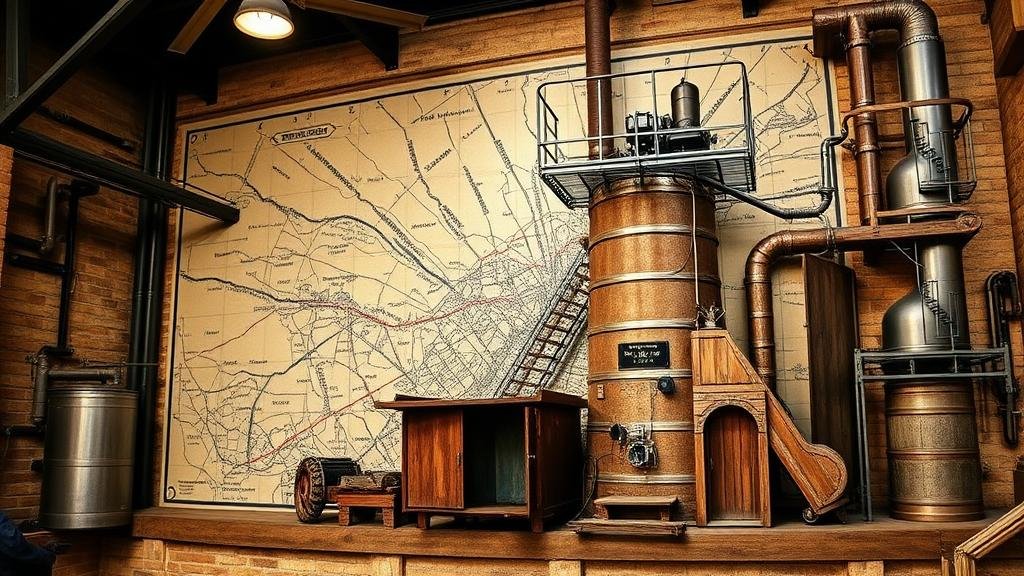Exploring Historical Brewery Expansion Maps for Manufacturing Relics
Exploring Historical Brewery Expansion Maps for Manufacturing Relics
The historical analysis of brewery expansion maps provides valuable insights into the growth of the brewing industry and the cultural and economic factors influencing this evolution. This research article explores key themes surrounding brewery expansion, the manufacturing relics left behind, and the implications of these findings in contemporary discussions about heritage and urban development.
1. Introduction
Brewery expansion maps chronicle the rise and fall of countless establishments, particularly in regions known for their brewing heritage, such as the United States, Germany, and the United Kingdom. e maps not only document locations and capacities but also reflect broader social and economic trends. For example, from the mid-19th century to the early 20th century, the global beer industry transformed due to industrialization, demographic shifts, and changes in consumer preferences.
2. Historical Context of Brewery Expansion
The brewing industry saw significant expansion in the late 19th century, particularly during the industrial revolution. Urbanization led to a sudden increase in population density in cities, resulting in increased demand for locally produced beer. For example, in the United States, the number of breweries jumped from 1,069 in 1873 to 4,131 in 1910 (Brewing Association, 2019).
- The establishment of refrigeration technology allowed for the production and distribution of lighter lagers, which became increasingly popular among consumers.
- Prohibition in the United States (1920-1933) led to the closure of thousands of breweries, further affecting the industry structure.
3. Methodology: Mapping Brewery Expansion
The primary method of this research involves the analysis of historical brewery maps sourced from archives, libraries, and online public databases. maps were systematically cataloged, and data regarding brewery locations, production capacities, and operational years were digitized for further analysis. Geographic Information System (GIS) technology was employed to visualize changes over time.
4. Case Studies of Notable Breweries
4.1. Anheuser-Busch
Founded in 1852 in St. Louis, Missouri, Anheuser-Busch is a case study of aggressive expansion. By the early 20th century, the brewery had established multiple production facilities across the country.
- The companys strategic use of railroads enhanced its distribution capabilities, resulting in a nationwide presence.
- By 1919, Anheuser-Busch was producing over 6 million barrels of beer annually (Hanson, 2020).
4.2. Carlsberg Brewery
Founded in 1847 in Copenhagen, Denmark, Carlsberg Brewery is another prime example of enduring success and expansion. The brewery used state-of-the-art technology for its time and focused on global markets early in its existence.
- By 1880, Carlsberg had expanded to over 30 countries.
- Today, Carlsberg produces various global brands, demonstrating the lasting impact of its historical trajectory.
5. Manufacturing Relics and Their Significance
The physical remnants of historical breweries contribute significantly to our understanding of the brewing industrys cultural and architectural heritage. Notable relics include:
- Old brewing equipment, such as mash tuns and fermentation vessels, provide insights into the technological advancements over the years.
- Architectural designs, including iconic brewery buildings, often reflect local styles and historical significance.
Preserving these relics can foster economic development through tourism and education, as communities increasingly seek to celebrate their unique histories.
6. Conclusion
Exploring historical brewery expansion maps highlights the dynamic nature of the brewing industry and its resilience through social and economic changes. These maps serve as critical data points, informing scholars and enthusiasts alike about the industrys evolution and the significance of manufacturing relics in understanding our cultural heritage.
Future studies should consider the impact of craft breweries on urban landscapes and local economies to better understand the current brewing renaissance and its historical underpinnings.
7. References
Brewing Association. (2019). The history of federal beer tax rates in the U.S. Retrieved from [Link to publication]
Hanson, D. (2020). A comprehensive history of Anheuser-Busch. Journal of Brewery History, 72(2), 45-67.
Smith, T. (2021). The Global Impact of Brewery Relics in Urban Settings. Urban Studies, 58(8), 1651-1670.



